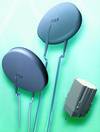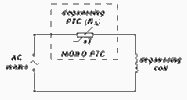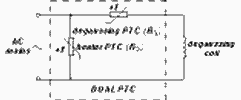

To minimise picture distortion and beam landing error (colour impurity), the shadow mask and associated metal parts of a CRT tube must be demagnetised at switch on. This is done by passing decaying AC through the degaussing coil. An alternating magnetic field is generated which gradually decays to demagnetise the tube.
BC Components says that by implementing its dual positive temperature coefficient (PTC) thermistor in the degaussing circuit, a significant improvement of picture quality can be achieved.
Connecting a PTC thermistor (mono PTC housed or leaded) in series with the AC mains and degaussing coil; as in Figure 1, is the simplest method of producing the required decaying current. At switch on, the PTC thermistor is cold and has low resistance, so a large inrush current flows through the degaussing coil. As both the temperature and, therefore, the resistance of the PTC thermistor increase, the current and magnetic field decay. The PTC temperature stabilises after a few minutes, leaving a small alternating residual current flowing through the degaussing coil.

Degaussing with dual PTC thermistors
To avoid picture distortion with large-screen television and high-resolution colour monitors, it is crucial that the residual current and hence the residual magnetic field, be as low as possible. A dual PTC thermistor in the degaussing circuit can achieve this.
The degaussing PTC is connected in series with the degaussing coil; see Figure 2. The heater PTC, with a higher R25 resistance (resistance at 25°C), is in parallel with the main supply. At switch on, the inrush current through the degaussing coil is high, raising the temperature and resistance of the degaussing PTC. The temperature of the heater PTC also increases and its heat is dissipated towards the degaussing PTC. This further increases the degaussing PTC resistance, so further reducing the residual current.

To maximise this heating effect and thereby minimise the residual current, the two thermistors are carefully matched and clamped in close thermal contact inside a PBTP (polybutyleneteraphthalate) case. The plastic composition of the case is self-extinguishing in accordance with UL94.V.0.
Further advantages can be obtained by using double mono PTC thermistors. This consists of a parallel combination of two degaussing PTC thermistors in one standard BC Components 3-pin housing. This component offers substantial benefits compared to a single PTC degaussing thermistor. Inrush currents can be higher than with normal dual or mono degaussing PTC thermistors and by doubling the normal ceramic volume, a smoother decay is obtained.
| Tel: | +27 11 458 9000 |
| Email: | [email protected] |
| www: | www.electrocomp.co.za |
| Articles: | More information and articles about Electrocomp |

© Technews Publishing (Pty) Ltd | All Rights Reserved